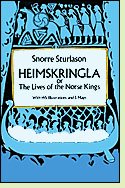Heimskringla
by Snorri Sturluson
Reviewed by David Maclaine

If you’re interested in Viking Age Scandinavia you will come, sooner or later, to the collection known as Heimskringla. This work by the great Icelandic writer Snorri Sturluson became known from a manuscript missing the first few pages, and was named for the top word on the first remaining page, meaning "the circle of the world." The usual subtitle is "The Lives of the Norse Kings." It is now generally accepted that the contents are historical fiction rather than anything that meets our present definition of history. These "Lives" include old traditions about Norwegian kings shaped into lively prose by Snorri in the thirteenth century, poems that survive from the ages in question, later legends about the kings' deeds, and a fair bit of narrative composed by Sturluson to weave these bits and pieces into a coherent pattern. As it happens, Sturluson was a fine story-teller, and his subject matter is as full of stirring sword-play, bold contenders battling for a throne, and sudden, shocking betrayals as you’ll find in Game of Thrones.
Heimskringla offers a series of sagas about Norse kings. The first, Ynglinga Saga includes a clever reframing of the story of the Norse gods and a series of lively miniatures about the early generations of the ruling dynasty. The crucial History of Harald Hairfair tells the fascinating tale of one ambitious regional king who set out to become king of all Norway, his varied wives and his surfeit of sons. Then comes an amazing series of tales about successive claimants, including two powerful kings named Olav and a giant named Harald Hardrade, men who won fame as sea raiders or mercenaries and eventually returned to contend for Norway’s throne. For good reason, this is the single source most used by later historical novelists who tackle the Viking Age. (ca. 1230; 832 pages in the 1990 Dover edition)
More about the Heimskringla at Powell's Books or Amazon.comHeimskringla appears on the list of The 45 Best Historical Novels Set in the Viking Age
Other novels about medieval Scandinavian royalty:
Styrbiorn the Strong by Eric R. Eddison (1926), about Styrbiorn Olafsson, an heir to the Swedish throne whose hot temper led to his being denied the kingship. See review or more info at Powell's Books
Mother of Kings by Poul Anderson (2001), about the Norse chieftain's daughter who becomes the wife of Eirlik Blood-Axe. See review or more info at Powell's Books
The Golden Horn by Poul Anderson (1980), about Harald Hardrade's struggle to become king of Norway in the eleventh century; #1 in the Last Viking trilogy. See review or more info at Amazon.com
Nonfiction about Snorri Sturluson and the sagas:
Songs of the Vikings by Nancy Marie Brown (2012), a biography of Snorri Sturluson. More info
Kings' Sagas and Norwegian History by Shami Ghosh (2011), a scholarly discussion of the reliability of the Norse kings' sagas as historical sources. More info
Iceland Saga by Magnus Magnusson (1987), about the sagas of Iceland and their relationship to the landscape. More info
Online:
The Heimskringla in English translation at the Wisdom Library website
Back to Novels of Scandinavia and the Vikings
Back to Directory of Book Reviews